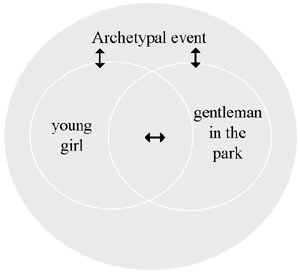Applied Psychoanalysis > Parapsychology |
A Psychoanalitical Approach
of a Case of Telepathy
By J Jones
I have recently received an e-mail from a respectable gentleman who tells us in a few
words about an event which took place while he was walking in the park C., in his hometown in Romania. In the end, he asks us what psychoanalysis can say about what happened. In short, he was crossing the park with the
intent of going home - he lives a bus station away from the park. At a certain point he surprised himself talking in his mind with an imaginary character - a reporter - about his fellow citizens lack of creativity. But the most
interesting part was that the dialogue (or more precisely the monologue) was held in English. In other words, our gentleman was mentally speaking in English, language which he spoke pretty well, explaining to the imaginary reporter
why his fellow citizens beat time at ever chapter. He had a personal theory which was just coming to light and which he went on with afterwards - after the happening narrated here - in order to write it down in an article which
will be published on a journal. Approximately 2-3 minutes after the imaginary dialogue had started he was stopped by a young lady who had an unfolded map in her hands and was accompanied by two young men. The young
lady addressed him in English the words "Do you speak English?", as she wanted to be explained how to get to a touring objective located in the park. Shocked by the coincidence, our gentleman confirmed he was
speaking English and managed to explain her elegantly and completely how to reach that particular site, surprising the young lady, who, obviously, did not think a Romanian would speak English fluently.
Our gentleman believes that this coincidence between his imaginary dialogue and the real one, both in the English language, can not be reduced to rational causes, and this is why he thought at psychoanalysis.
"Why not parapsychology?" we ask. To be honest "the coincidence" from the park seems to be a case of long distance thinking transmission. "Parapsychology has no explanations - we are told - but only facts". And one of its major
minuses is that it does not make the difference between real and reliable events and the imaginary ones, consciously or unconsciously forged. Freud also addresses in a few essays occult phenomenas, as he used to call
them at that moment. Without pretending he knew all about their meaning he said there was no doubt a transmission of thoughts on extra sensorial paths. But he refers to the theory of neurosis as an explanation and says that the
repressed desires of the sender are the ones to be transmitted. As for such practices as telling fortunes, the fortune teller presents a medium sensibility which makes possible the reception of the transmitted information, etc. (1)
But there are authors who affirm that it was often observed during the psychoanalytical therapy a transfer of information through extra-sensorial paths from the psychoanalyst to the patient. Patients are often up to
date with problems and hidden biographical aspects of their psychoanalysts. This transmission, we would add, is a phenomenon which is engaged by the positive transference from the patient to the psychoanalyst. It is possible that
other configuration also exist which permit the extra-sensorial transmission of intimate information. In the above case these conditions are NOT met, that is, an intimate psychoanalytical type (psychoanalyst-patient)
relationship which assumes a positive transfer or a medium receptivity of the gentleman who narrated the event (we do not know if the young lady, who asked for advice, possesses such receptivity). But symbolically, the
relationship established between the young woman who was looking on a map for a touring landmark and the person who was walking in the park talking to himself in English, met by accident, was a psychoanalytical one.
In psychoanalysis we assume, beside the transference, a master-disciple type communication structure. (2) This structure can be an activated archetype, according to Jung's ideas in this respect. (3) Or the archetype -
typical situation - is gifted with a specific energy, is autonomous, it engages the communication between two persons who are in a symbolic master-disciple type relationship... The theory of archetypes (as
inborn patterns of behavior) let us off the explanation of whom or what was at the beginning: the need for instructions of the young woman or the gentleman's predilection to offer directions? Archetypal coincidences are not-causal,
which means that they are not determined by usual A->B cause-effect type sequences. The graphical representation of the archetypal situation would look like this:
 |
The diagram specific to the telepathic communication
in the relation with an archetype
--
Notes:
1. There are a few essays of Freud treating of occult phenomena: Dreams and Telepathy (1922), Dreams and Occultism (from the New Introductory Lectures on Psychoanalysis - 1933), Psychoanalysis and Telepathy
(1921).
2. There are a lot of typical situations: mother/son-daughter, father/son-daughter, he lover-she lover, hero-antihero, small child-birth etc.
3. More about Jung's theories may be found at
http://www.carl-jung.net.![]()
<=
Back to the Applied Psychoanalysisor to the
HomepageCopyright 2002-2025, AROPA. All rights reserved.